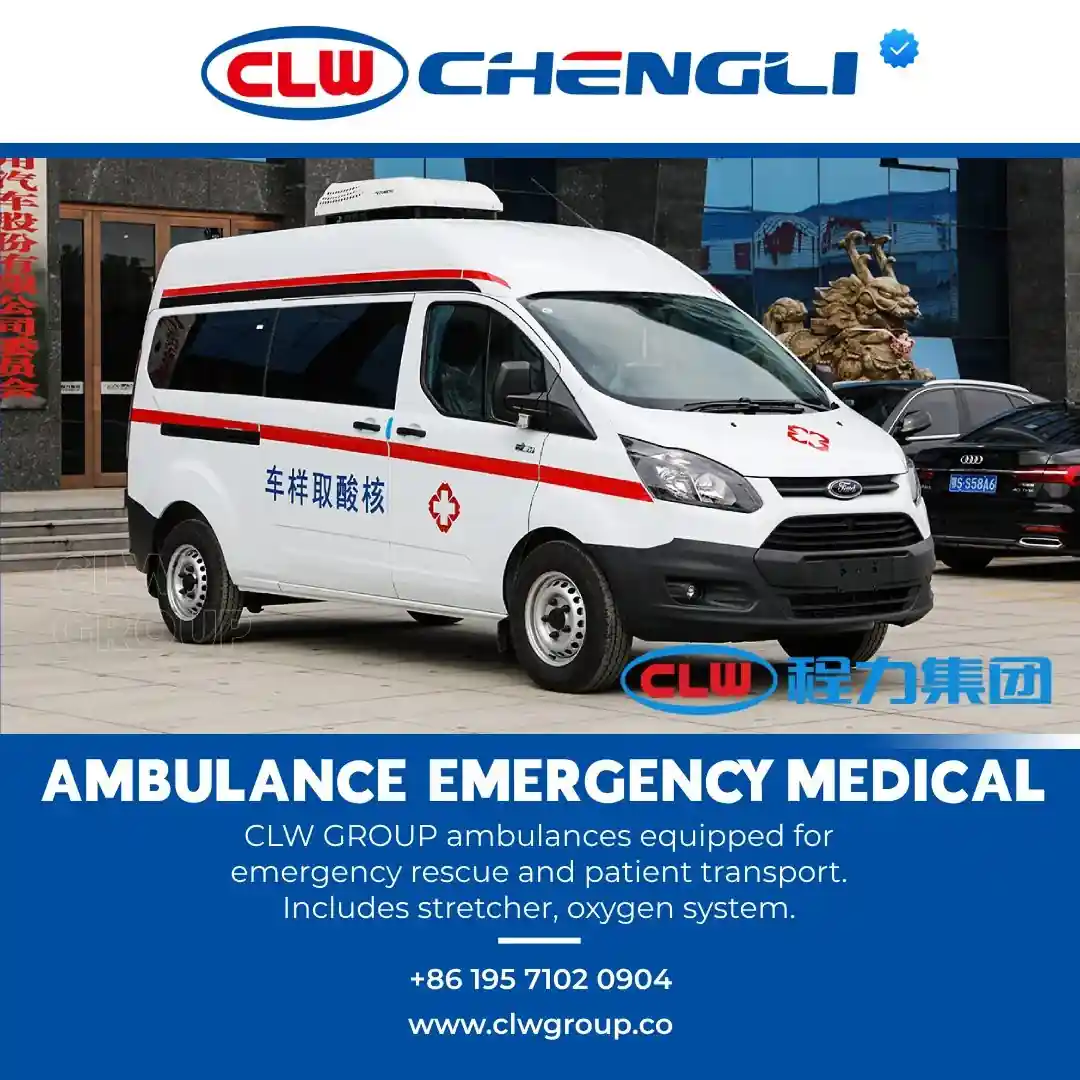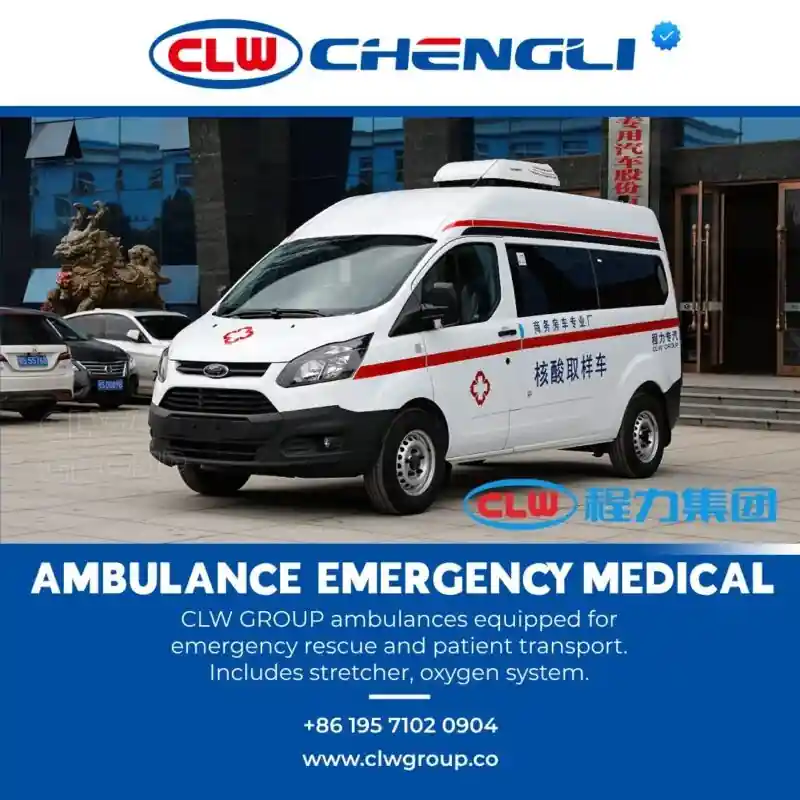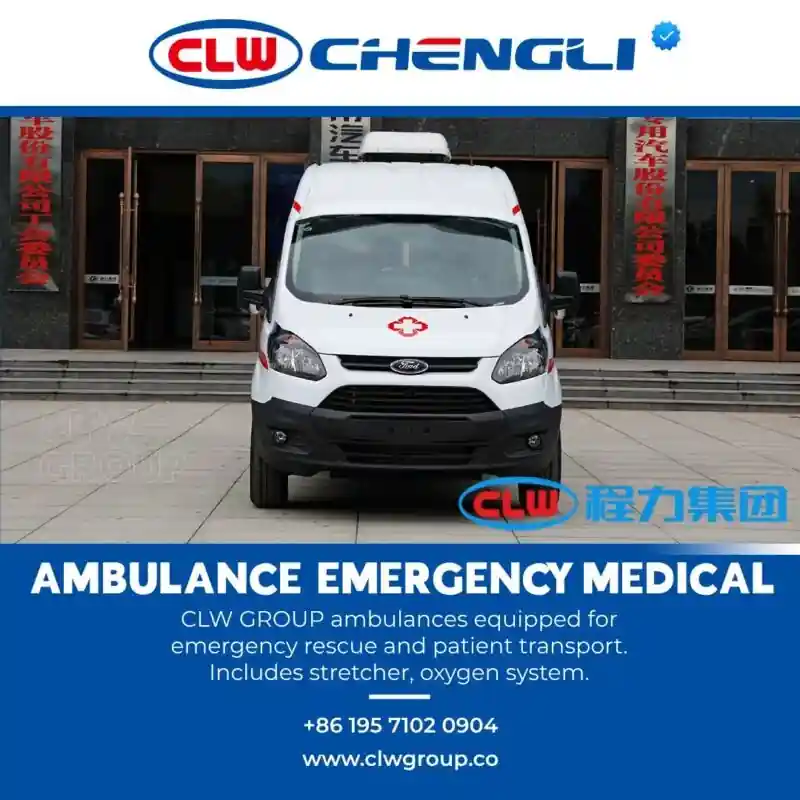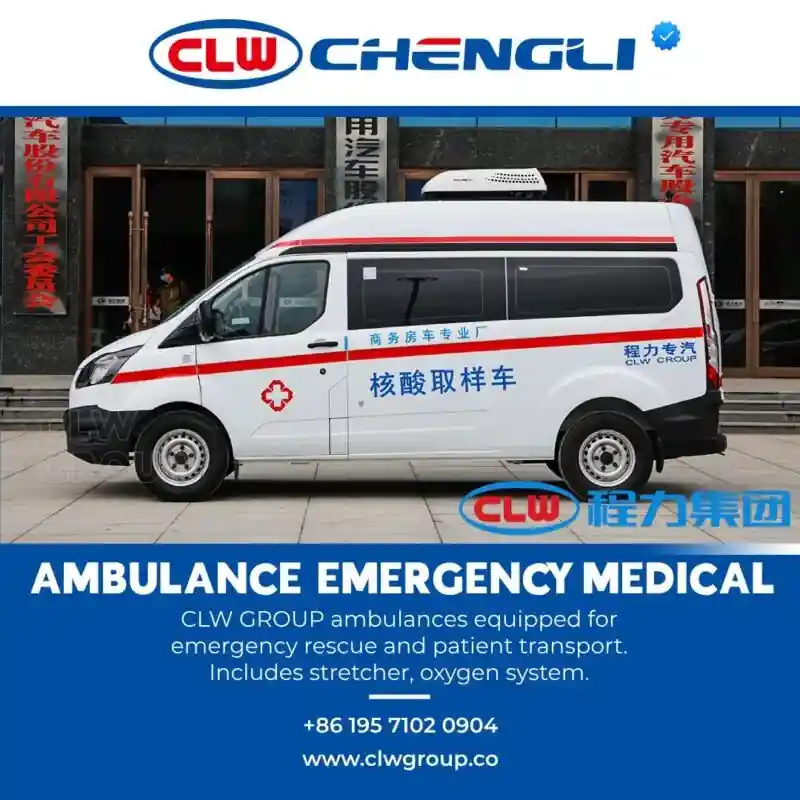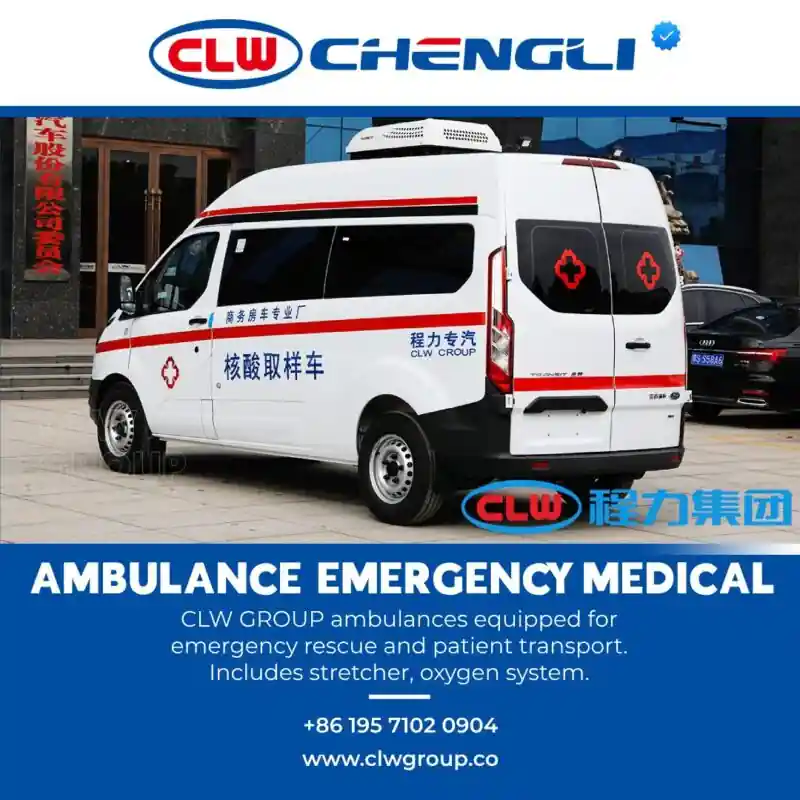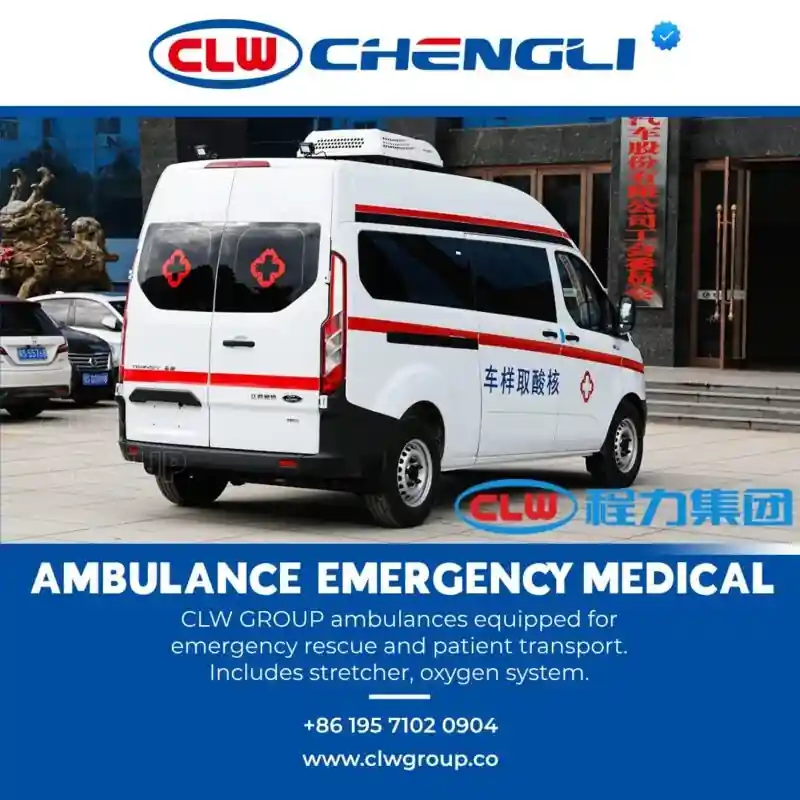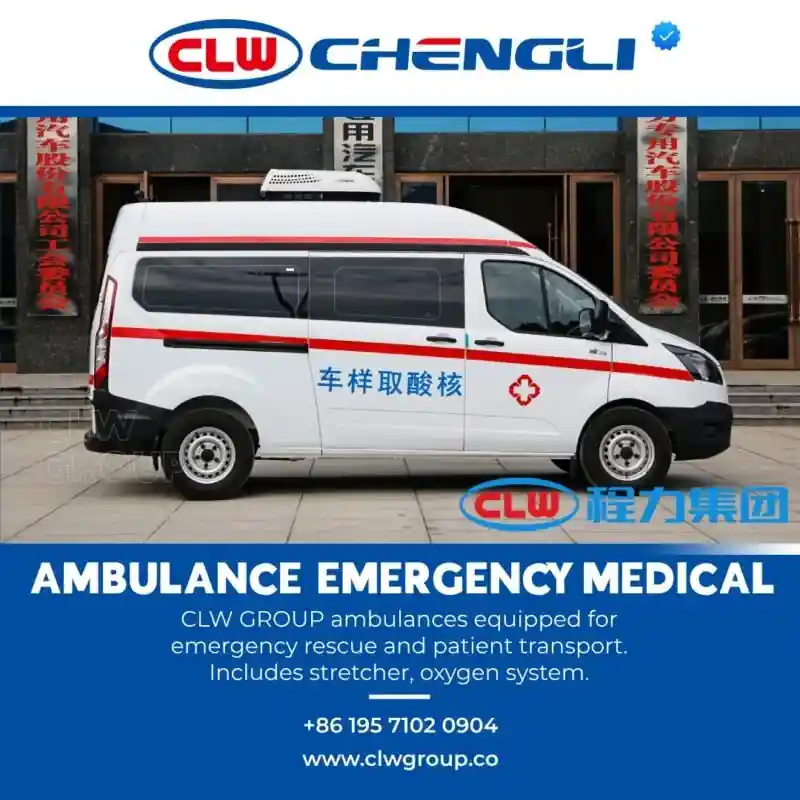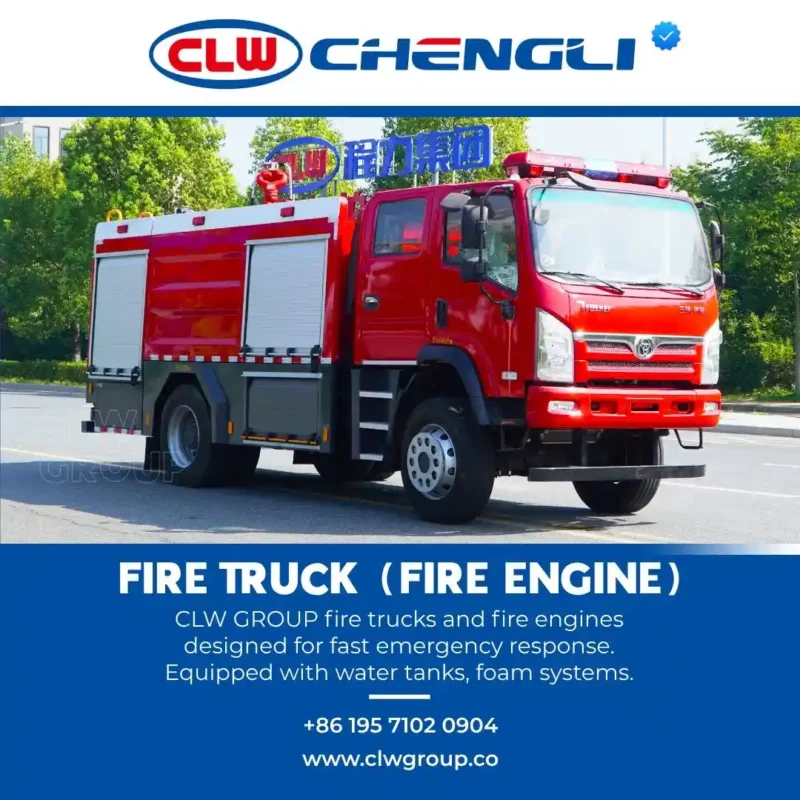Ambulance / Emergency Medical Van – Patient Transport & Rescue Vehicle with Medical Equipment
CLW GROUP ambulances equipped for emergency rescue and patient transport. Includes stretcher, oxygen system, emergency lights, sirens, and medical cabinets. Built on Iveco, Ford Transit, JMC, or Maxus.
Fast Response. Safe Transport. Life-Saving Design.
CLW GROUP Ambulances are built for speed, stability, and life-saving functionality. Designed to transport injured or critically ill patients to medical facilities safely and efficiently. Fully equipped with modern EMS tools and ergonomic interiors for first responders.
Key Features:
✔️ Basic Type (Transport) & Advanced Life Support (ALS) Options
✔️ Medical cabinets, oxygen system, IV hangers, power sockets
✔️ Automatic or manual stretcher with locking system
✔️ Interior ventilation, LED lighting, non-slip floor
✔️ Emergency light bar, siren, rear access doors
✔️ Built on Ford Transit, Iveco, JMC, Maxus, or custom chassis
Used by hospitals, fire departments, disaster response teams, and private EMS services globally.
Technical specifications:
| Specification | Details |
|---|---|
| Chassis Brand | Ford Transit / Iveco / JMC / Maxus / Custom |
| Drive Type | 4×2 / 4×4 (optional) |
| Ambulance Type | Basic Life Support (BLS) / Advanced (ALS) |
| Medical Equipment | Stretcher, Oxygen System, IV Hanger, Monitor Shelf |
| Interior Features | Ventilation, LED Lights, Power Socket, Non-slip Floor |
| External Features | Light Bar, Siren, Rear Door, Reflective Tape |
| Optional Features | Defibrillator, Ventilator, Rear Camera, AC Unit |
Ambulance / Emergency Medical Van – Patient Transport & Rescue Vehicle with Medical Equipment
Introduction to Ambulance and Patient Transport Vehicles
In the healthcare and emergency response ecosystem, the ambulance plays a vital role in patient transport, rescue operations, and providing medical care during transit. These vehicles are specially designed to ensure the safe, fast, and efficient movement of patients who require emergency medical services or non-emergency transportation. From the urban hospitals to remote rescue locations, the ambulance van is the first line of defense in delivering life-saving interventions.
This comprehensive guide offers an in-depth look into various types of medical ambulances, their configurations, features, use cases, and how they align with global clinical practice protocols and regulatory requirements.
Types of Ambulance Vans for Patient Transport
Emergency Ambulances
Emergency ambulances are used to transport patients who need immediate medical attention. These vehicles are fully equipped with life-saving equipment, staffed by trained paramedics, and feature emergency lights and sirens for fast passage through traffic.
Non-Emergency Patient Transport Vehicles
These are meant for patients who require clinical supervision but not emergency care. Examples include hospital discharges, routine appointments, and long-distance relocations. These units follow strict non-emergency patient transport regulations 2016 in many regions.
Rescue and Rapid Response Units
Often referred to as emergency response vehicles, these are deployed in rescue missions where immediate action is critical. They carry medical equipment, trauma kits, and sometimes foldable stretchers for patients who need rapid evacuation.
Key Components of a Medical Ambulance
Main Stretcher and Foldable Units
Every ambulance includes a main stretcher, usually hydraulic or electric, and additional foldable stretchers to support multiple patients. These ensure safe and comfortable handling of patients during transport.
Oxygen Tanks and Life Support Equipment
Advanced units feature oxygen tanks, life support monitors, ventilators, and defibrillators. These are crucial for providing immediate medical care, especially during critical transfers.
Interior Layout and Accessibility
A well-designed interior improves practicality, storage efficiency, and ease of movement. Many ambulances have spacious compartments with medical cabinets, disinfection lamps, and storage cabinets for safety and hygiene.
Vehicle Specifications and Chassis Options
Popular Chassis Brands
- Toyota (e.g., Land Cruiser, Hiace)
- Ford Transit
- Mercedes-Benz Sprinter
These chassis types are chosen based on maneuverability, durability, and ease of customization.
High Roof and Armored Options
Some ambulance vans come with high roof designs for added headroom, while armored variants are available for use in conflict zones or high-risk areas.
Air Conditioning and Power Supply
Each vehicle features independent air conditioning, inverter systems, external power, and onboard power supply sockets for medical equipment.
Medical Equipment Installed in Ambulance Vans
- Oxygen cylinders
- Defibrillators
- ECG machines
- Ventilators
- Infusion pumps
- Suction units
All equipment is integrated securely to handle road vibration and enable supervision during transport.
Regulatory Standards and Clinical Practice Protocols
Ambulances are required to comply with department of health regulations and clinical practice protocols. This includes the installation of:
- Warning lights
- Secure storage for support equipment
- Proper interior layout for ease of use
- Disinfection and safety measures
Transport Services and Use Cases
Health Service Providers
Hospitals, NGOs, and private clinics use ambulance vans for:
- Hospital to hospital transfers
- Dialysis or oncology transport
- Scheduled home visits by health professionals
Government and Emergency Agencies
Used for mass rescue efforts, national emergencies, and rural outreach programs.
Customized Ambulance Manufacturing
Manufacturers like CLW Group offer customizable units based on user need:
- Passenger vehicles converted to medical ambulances
- Units designed with extra accessibility for wheelchairs
- Models configured with high-performance air conditioning and life support setups
Design and Construction Considerations
Practical Layout
Ensuring ergonomic and practicality-based layout improves response time inside the ambulance.
Secure Integration
All medical transport elements are securely fastened and integrated using modern cutting-edge manufacturing practices.
CLW Group also offers a specialized fuel tanker truck engineered for the safe, high-capacity transport of petrol, diesel, and other liquid fuels.Summary: Why Ambulance Vans Are Vital for Medical Care
Ambulance vans represent the intersection of automobile design and medical transportation. Whether for non-emergency needs or emergency medical interventions, these vehicles must be:
- Fully compliant with international regulatory requirements
- Outfitted with high-grade medical equipment
- Engineered for safe and comfortable transport
